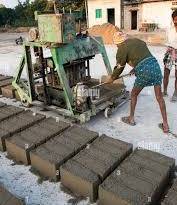4. ARCHES
Arches are structural members used in a building to bridge across the opening of doors, windows, or cupboards etc. to support the weight of the superimposed masonry by arch action.
Arch action;-It consist of small wedge shaped units joint together by mortar.
But arches made of steel and Rcc are builtinsingle unit without the use of wedge shaped units
and are used for bridge constructions.
Terms;-
Intrados:-the inner curve of arches
Soffit- Inner surface of arch
Extrados- Externalcurve of arch
Voussoirs-wedge shaped unit forming courses of an arch
Skewback- inclined surface of abutment.it is prepared to receive the arch
Springer - first voussoirs at springing level on either side of arch which is adjacent to skewback
Crown - highest point of extrados
Key - wedge shaped unit at crown of arch. It is made prominent by making it of larger section
nad projected above and below the outline of arch.
Abutment - the end support of arch
Piers - intermediate support of an arcade.
Springing point- point from which curve of arch springs
Springing line- imaginary horizontal line joining 2 springing points Span - clear horizontal distance between supports
Rise - clear vertical distance between highest point on intrados and springing line Centre- geometrical centre of arch curve
Ring- circular course forming on arch
35 * Under revision
Depth or height- perpendicular distance between intrados and extrados
Spandril- irregular triangular shape formed between extrados and horizontal line drawn
tangent to crown
Haunch- the lower half portion of arch between crown and skewback
Arched - row of arches supporting a wall above and supported by piers
Thickness of soffit- horizontal distance measured perpendicular to the front and back face of an arch
Impost - projecting course at upper part of a pier and abutment to stress the springing line.
The arch may be defined as a mechanical arrangements of wedge shaped blocks of stone or bricks which mutually support each other and entire arch is supported at ends by piers or abutments. The wedge shaped units are so arranged together along a curve line that they balance their own weight by mutual pressure and exert a vertical pressure only which can be sustained by support below.
Stability consideration
• Stability of arches depends on friction between surfaces of voussoirs and cohesion of mortar.
• Stability of arches is endangered by
(i) Crushing of arch material
(ii) Sliding of voussoirs
(iii) Rotation / overturning about an edge
(iv) Differential settlement of supports
To maintain the stability or equilibrium of arches, points to be noted
(I) Crushing of arch ;-
To prevent crushing of arch material which occurs when thrust at some point of arch
creates the safe crushing strength of material, points considered are:-
(a) Size of voussoirs should be adequate to resist anticipated thrust.
(b) For small spans , thickness at arch ring is kept uniform from crown to springing.
36 * Under revision
Thickness of ring = 1 * span Or 12
thickness = 20 cm for span upto 1.5 m
= 30 cm for span between 1.5m to 4m
= 40 cm for span between 4m to 7.5 m
(c) For large spans (> 7 cm) , thickness of arch ring may be increased at springing by about 20% to thickness at crown.
(d) Only first class blocks should be used and for large spans arches may be strengthened by steel reinforced so that safe crushing strength is not exceeded.
(II) Sliding of voussoirs :- To prevent sliding of one over after-:
(a) All bed joints should be perpendicular to the line of the least resistance, normally they are made normal to the curve of arch, where they are nearly perpendicular to the line of least resistance.
(b) Depth of the voussoirs should be adequate to resist the tendency of joints to open and slide upon one after other.
(III) Rotation about wedge -:To prevent this
(a) Line of resistance/thrust at any section should be within middle third of arch
height.
(b) Thickness of arch and its curve are so designed that time of thrust atleast fall within the section and crosses each joint away from edge.
(IV) To safeguard against differential settlement :-
(a) Abutments should be sufficiently strong to resist the thrust of arch due to self-
weight and superimposed loads.
For abutments of ample size – segment arch is strongest
For smaller size of supports- semi-circular / pointed arch is used
Semi-circular arch is strongest and exerts no thrust on abutments and piers.
(b) Whatever may be the shape of arch, it should be symmetrical to avoid differential settlement of support.
37 * Under revision
Types of arches
(I)Classification according to no. of centres -: Outline of intrados / soffit may be formed by a single arc / combination of arcs of various radii and centres and so named as one centre, two centred, 3 centred arcs
* One centred arch- They have only one centre .The types are semi-circle, segmental arch(less than a semi-circle), horse shoe arch (more than a semi-circle),
Stilted arch (semi-circular with 2 verticals portions at springing’s), bulls eye arch (complete circular arch)
* Two centred arch- They are
(a)Blunt arch- Both centres are within the arch itself.
(b)Gothic/Equilateral/pointed arch-Radii of arches are equal to span and centres are on springing points.
(c)Acute/laneet arch-both the centres lie on the springing line but outside the springing points.
* Three centred arch-
(a)Elliptical arch-It is the form of semi ellipse, Two centres are used for making up
the ends and the third is used to draw the central position.
(b)3 centred drop arch-procedure here is reversed. Ends of the arch formed by arc, central portion is drawn by the other 2 centres.
*Four centred arch-Two arch are on the springing line and two are Below the springing line.
*five centred arch-It looks like semi-elliptical arch. Its procedure is as following
(i) first draw the springing line and divide into 5 parts.
(ii)With centres as A and B draw arches of radius equal to span intersecting at point C5. Join C5 with 2 and 3.and produce indefinitely.
(iii)With centres as C1 and C2 and radius 3 divisions(i/e 1-4) draw arches intersecting at 4.
(iv)Join OC1 and OC2 intersecting lines C5-2 and C5-3 and C3 and C4.
38 * Under revision
(v)points C1, C2, C3, C4, C5 are the centre of the arch.


